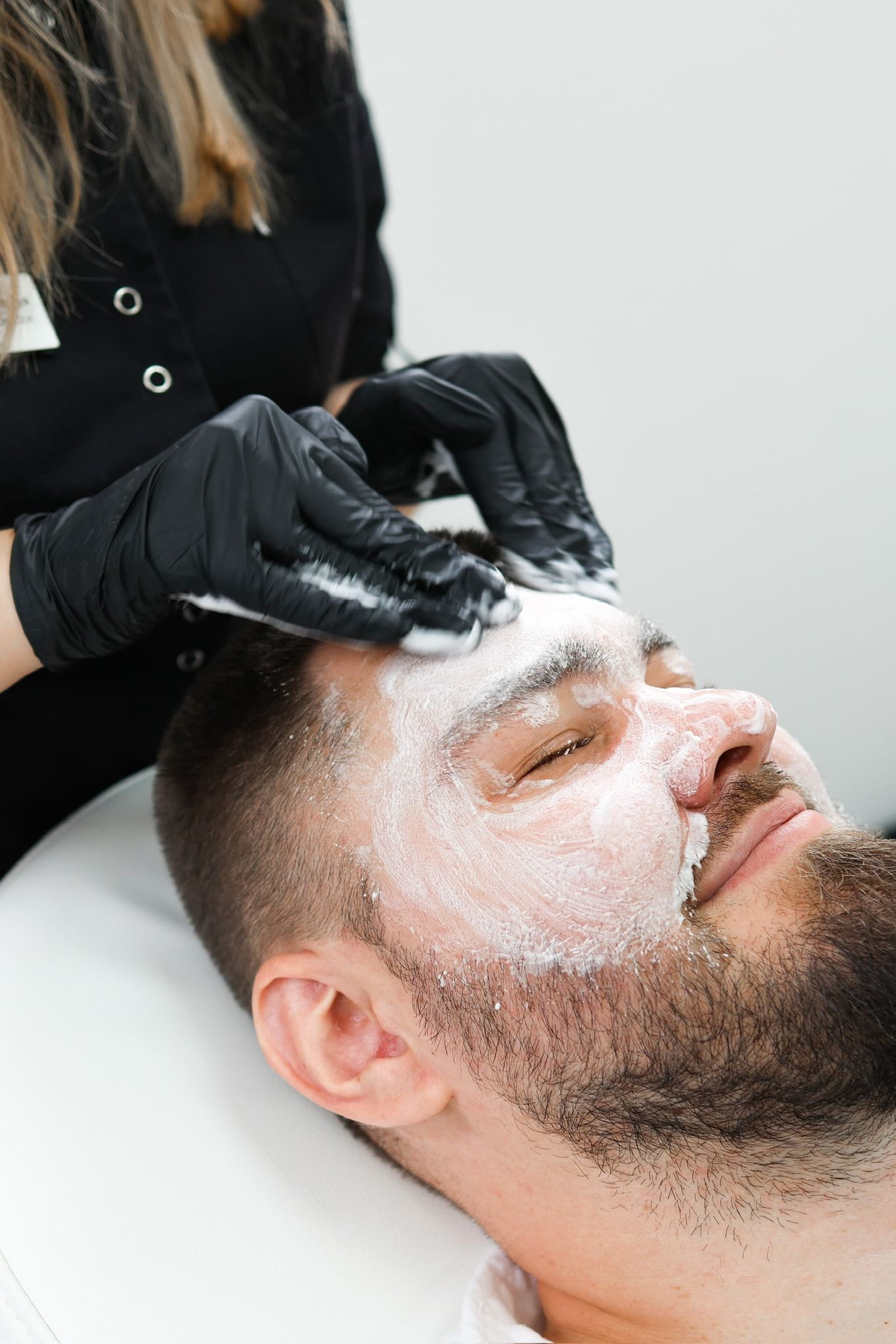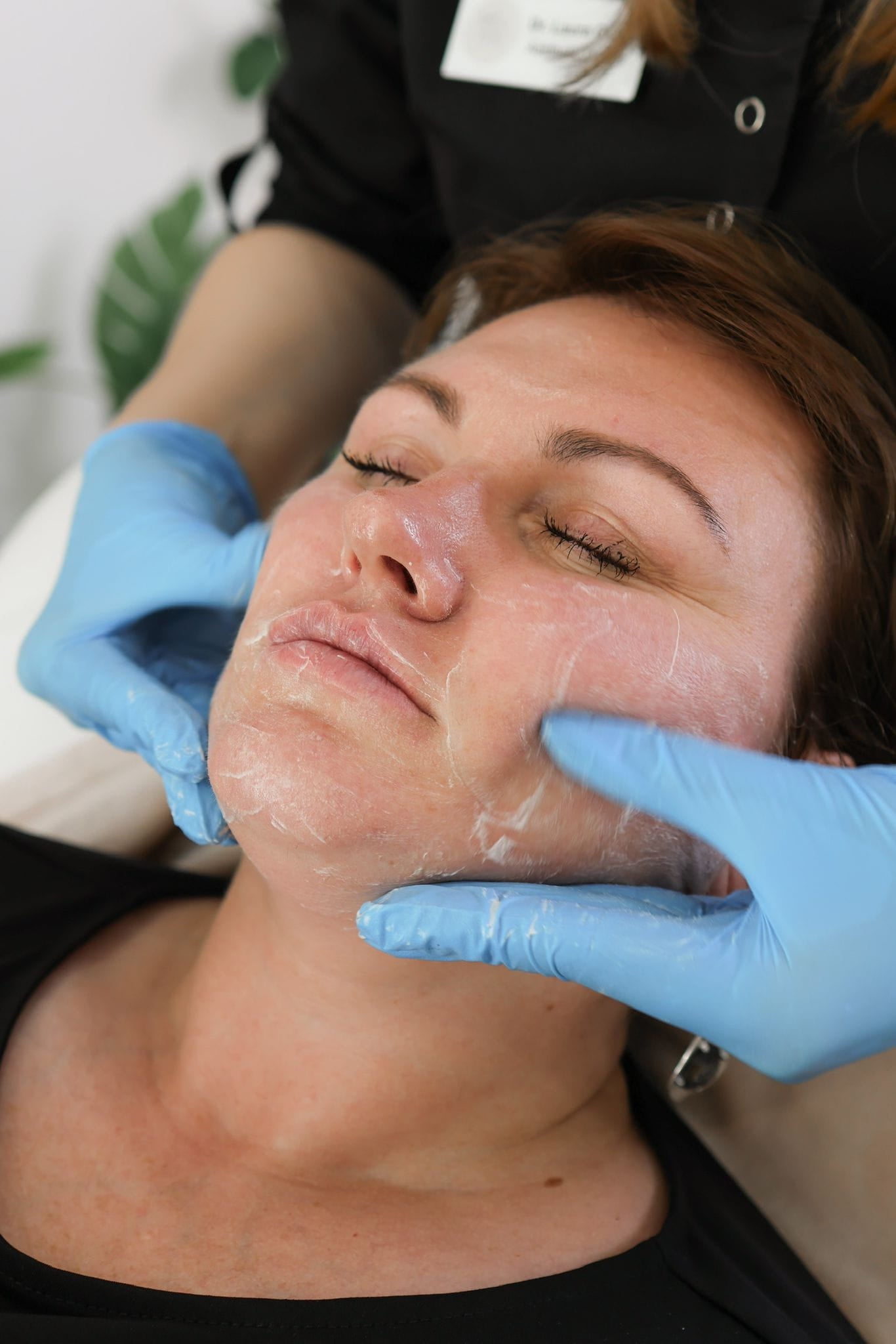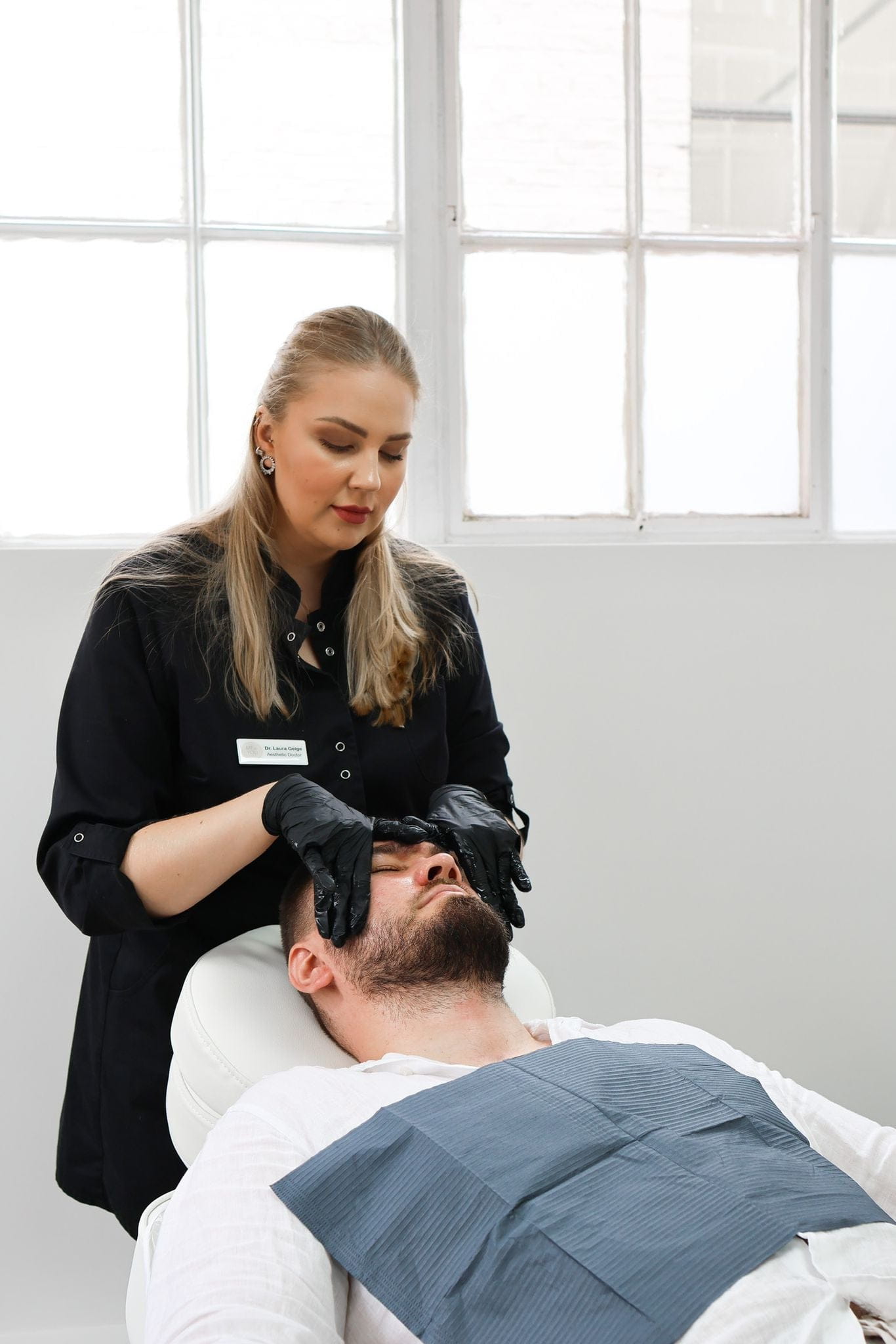Cosmelan Depigmentation Peel
The quest for even-toned skin often leads individuals to explore various treatments for pigmentation issues. Two popular options gaining traction in the UK are Cosmelan Depigmentation Peel and microneedling.
Mechanism of Action
Cosmelan Depigmentation Peel is a chemical peel that works by inhibiting melanin production, the pigment responsible for skin color. It contains a potent blend of ingredients, including kojic acid, hydroquinone, and phytic acid, which target different stages of melanin synthesis. Kojic acid interferes with tyrosinase, an enzyme crucial for melanin formation. Hydroquinone blocks melanin production directly. Phytic acid inhibits melanosome transfer, preventing the distribution of pigment to skin cells.

Benefits for Pigmentation
The Cosmelan Depigmentation Peel’s efficacy lies in its multi-pronged approach to pigmentation reduction. By addressing various stages of melanin synthesis, it effectively lightens dark spots, age spots, and hyperpigmentation caused by sun damage or hormonal changes.
This peel is particularly beneficial for treating melasma, a common type of pigmentation disorder characterized by brown patches on the face. It’s important to note that Cosmelan requires multiple treatments spaced weeks apart, followed by maintenance applications.
Downtime and Recovery
Downtime and recovery after a Cosmelan Depigmentation Peel typically involve a period of sensitivity and peeling. Immediately following the treatment, expect redness, mild swelling, and tightness in the treated area. This initial discomfort usually subsides within a few days. A mild to moderate exfoliation process begins a few days after the peel, resulting in flaking and shedding of pigmented skin cells.
It’s crucial to avoid sun exposure during this recovery phase and diligently apply sunscreen with at least SPF 30 to protect the newly regenerated skin from further pigmentation. The entire recovery process can take up to two weeks, depending on individual skin types and treatment intensity. During this time, gentle skincare products formulated for sensitive skin are recommended.
Cost Considerations
Cost considerations for Cosmelan Depigmentation Peel in the UK can vary significantly based on several factors. The number of treatments required, as Cosmelan often involves a series of sessions, plays a major role.
Geographic location within the UK also influences pricing, with larger cities or areas with higher living costs tending to have higher treatment fees. The specific clinic or practitioner’s experience and reputation can also impact the cost.
It is generally advisable to consult with a qualified dermatologist or aesthetics practitioner for an accurate cost estimate tailored to individual needs and skin type.
Suitability
Cosmelan Depigmentation Peel is a suitable treatment option for individuals seeking to address pigmentation concerns such as dark spots, age spots, melasma, and sun damage.
Its efficacy stems from the combined action of its key ingredients, which target multiple stages of melanin production, resulting in noticeable lightening of pigmented areas.
However, it’s important to understand that Cosmelan requires a series of treatments spaced weeks apart, followed by maintenance applications to achieve and sustain optimal results.
Those considering this treatment should be prepared for a recovery period involving sensitivity, peeling, and potential redness. Strict sun avoidance and diligent sunscreen use are crucial during the healing process.
Microneedling for Pigmentation
Microneedling is a minimally invasive cosmetic procedure that involves using fine needles to create controlled micro-injuries in the skin. These tiny punctures stimulate collagen production and cell turnover, promoting skin rejuvenation and addressing various concerns, including pigmentation.
Mechanism of Action
Microneedling works on pigmentation by triggering the skin’s natural healing process. The creation of these microscopic wounds stimulates fibroblasts, the cells responsible for producing collagen and elastin, which provide structure and elasticity to the skin. This increased collagen production helps improve skin texture, reduce the appearance of scars, and minimize the visibility of pigment irregularities.

Additionally, microneedling can facilitate better absorption of topical skincare ingredients by creating tiny channels in the stratum corneum, the outermost layer of skin. This allows products containing brightening agents like vitamin C or hydroquinone to penetrate deeper and work more effectively in reducing pigmentation.
Benefits for Pigmentation
Microneedling offers several benefits for addressing pigmentation issues.
- Collagen Stimulation: Microneedling triggers the production of collagen, which helps improve skin texture and reduce the appearance of pigmentation by evening out skin tone.
- Enhanced Product Absorption: The tiny punctures created by microneedling allow topical skincare products containing brightening agents to penetrate deeper into the skin, enhancing their effectiveness in reducing pigmentation.
- Reduced Scarring: Microneedling can improve the appearance of acne scars and other types of scarring, which may contribute to uneven skin tone.
Downtime and Recovery
Microneedling for pigmentation involves using fine needles to create micro-injuries in the skin. These injuries stimulate collagen production and cell turnover, leading to improved skin texture and reduced pigmentation.
Downtime and recovery after microneedling are generally minimal compared to procedures like chemical peels. You can expect mild redness, tingling, or sensitivity for a few hours to a day after the treatment.
- Within a few days, any redness should subside, and you can return to your normal skincare routine.
- It’s important to protect your skin from sun exposure during the recovery period, as it may be more sensitive to UV rays.
Cost Considerations
Cost considerations for microneedling in the UK can vary depending on factors such as the number of treatments required, the practitioner’s experience, and geographic location.

A single microneedling session typically costs between £100 to £300, with multiple sessions often recommended for optimal results.
It’s essential to consult with a qualified practitioner to determine the appropriate treatment plan and get an accurate cost estimate.
Suitability
Microneedling is a minimally invasive cosmetic procedure that involves using fine needles to create controlled micro-injuries in the skin. These tiny punctures stimulate collagen production and cell turnover, promoting skin rejuvenation and addressing various concerns, including pigmentation.
Microneedling works on pigmentation by triggering the skin’s natural healing process. The creation of these microscopic wounds stimulates fibroblasts, the cells responsible for producing collagen and elastin, which provide structure and elasticity to the skin. This increased collagen production helps improve skin texture, reduce the appearance of scars, and minimize the visibility of pigment irregularities.
Additionally, microneedling can facilitate better absorption of topical skincare ingredients by creating tiny channels in the stratum corneum, the outermost layer of skin. This allows products containing brightening agents like vitamin C or hydroquinone to penetrate deeper and work more effectively in reducing pigmentation.
Microneedling offers several benefits for addressing pigmentation issues.
- Collagen Stimulation: Microneedling triggers the production of collagen, which helps improve skin texture and reduce the appearance of pigmentation by evening out skin tone.
- Enhanced Product Absorption: The tiny punctures created by microneedling allow topical skincare products containing brightening agents to penetrate deeper into the skin, enhancing their effectiveness in reducing pigmentation.
- Reduced Scarring: Microneedling can improve the appearance of acne scars and other types of scarring, which may contribute to uneven skin tone.
Microneedling for pigmentation involves using fine needles to create micro-injuries in the skin. These injuries stimulate collagen production and cell turnover, leading to improved skin texture and reduced pigmentation.
Downtime and recovery after microneedling are generally minimal compared to procedures like chemical peels. You can expect mild redness, tingling, or sensitivity for a few hours to a day after the treatment.
- Within a few days, any redness should subside, and you can return to your normal skincare routine.
- It’s important to protect your skin from sun exposure during the recovery period, as it may be more sensitive to UV rays.
Cost considerations for microneedling in the UK can vary depending on factors such as the number of treatments required, the practitioner’s experience, and geographic location.
A single microneedling session typically costs between £100 to £300, with multiple sessions often recommended for optimal results.
It’s essential to consult with a qualified practitioner to determine the appropriate treatment plan and get an accurate cost estimate.
Comparing Cosmelan and Microneedling
Two increasingly popular treatments gaining traction in the UK for addressing pigmentation issues are Cosmelan Depigmentation Peel and microneedling.
Factors to Consider
Both Cosmelan Depigmentation Peel and microneedling offer effective solutions for pigmentation concerns, but they work through distinct mechanisms. Cosmelan is a chemical peel that directly targets melanin production, while microneedling stimulates collagen synthesis to improve skin texture and indirectly address pigmentation.
When deciding between the two, consider your specific skin type, pigmentation concern, desired outcome, downtime tolerance, and budget. Cosmelan is particularly suitable for treating melasma and stubborn dark spots, as it effectively inhibits melanin synthesis. However, it requires multiple sessions and involves a longer recovery period with potential peeling and sensitivity. Microneedling is a gentler procedure with minimal downtime, making it suitable for those seeking gradual improvement in skin texture and tone. It’s also beneficial for addressing acne scars and uneven pigmentation.
Ultimately, consulting with a qualified dermatologist or aesthetics practitioner is essential to determine the most appropriate treatment option tailored to your individual needs and skin condition. They can assess your skin type, pigmentation concerns, medical history, and lifestyle factors to recommend the best course of action for achieving desired results.
Ask about the Cosmelan Depigmentation Peel process at It’s Me & You Clinic with Dr. Laura Geige.
- Skin Treatment & Skincare Consultations Near Banstead, Surrey - November 18, 2025
- Skin Pen Microneedling Near Merstham, Surrey - November 17, 2025
- Skin Pen Microneedling Near Beddington, Surrey - November 16, 2025
